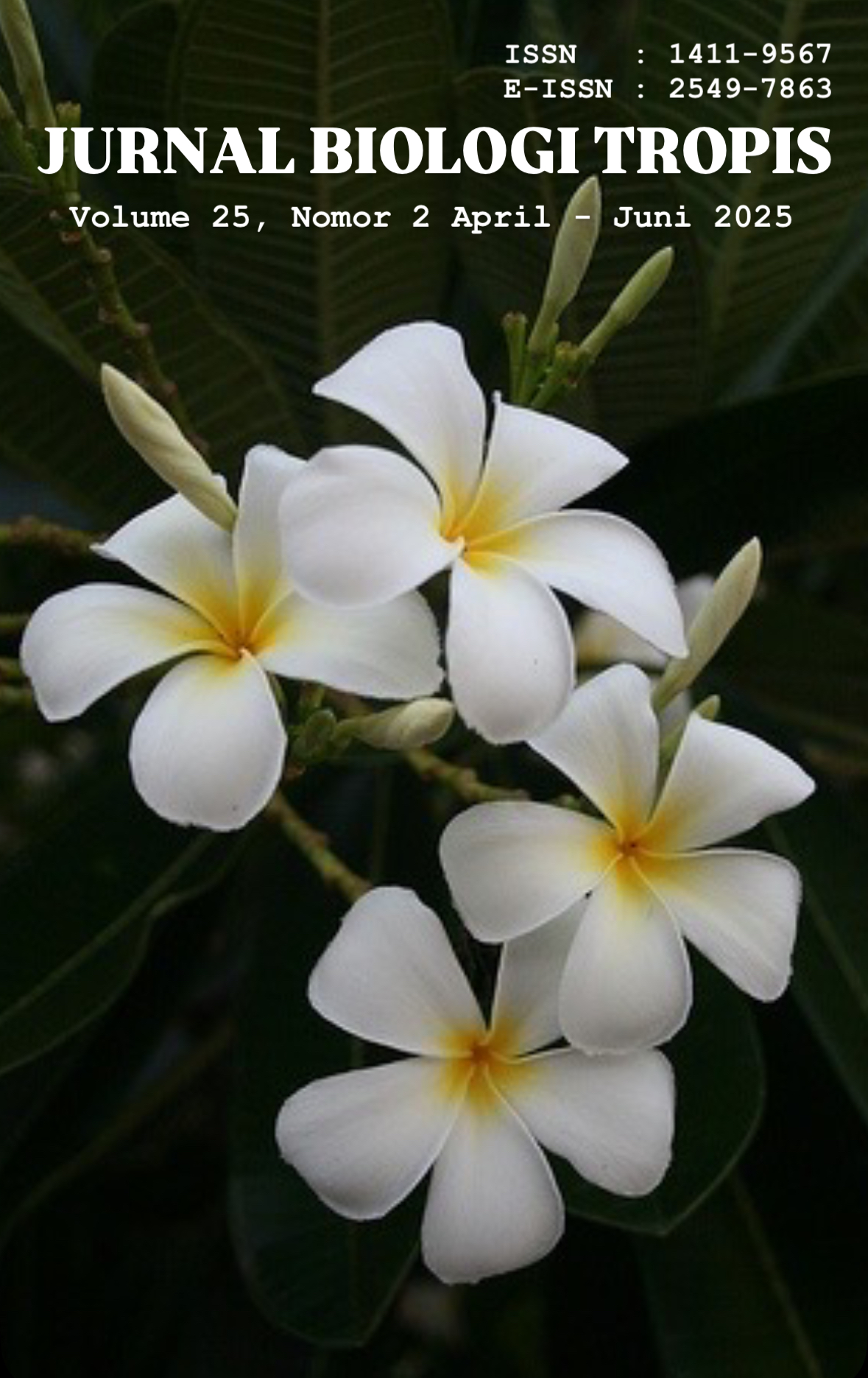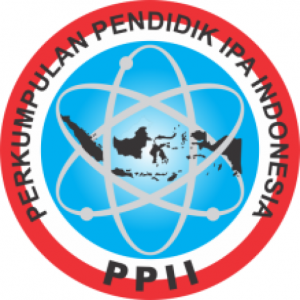Phenology of Flowering Time and Flowering Duration of Cucumber Plants in Padang and Kamang Magek
Authors
Silvi Pebriyeni , Vauzia Vauzia , Azwir Anhar , Reki KardimanDOI:
10.29303/jbt.v25i2.8887Published:
2025-05-07Issue:
Vol. 25 No. 2 (2025): April-JuniKeywords:
Cucumber, climate, environmental conditions, phenology, productivity.Articles
Downloads
How to Cite
Downloads
Metrics
Abstract
Cucumber (Cucumis sativus L.) is a high-value horticultural crop widely used as fresh vegetables, processed food ingredients, and cosmetic products. In addition, cucumber contains important nutrients for health, such as vitamin C, vitamin K, and various essential minerals. As a plant with many benefits, cucumber is greatly influenced by climatic conditions, which can directly affect productivity and harvest quality. Based on this, a study on the phenology of cucumber plants under two different climatic conditions was conducted. This study used an experimental method involving 20 cucumber plants, with two location treatments and two replications. The observed parameters included the time of flower emergence and flowering duration. The study was conducted from September to December 2024 at two locations, Kamang Magek and Padang. The data were analyzed using a t-test with a significance level of 5%. The results of the study showed significant phenological differences between cucumber plants grown in Kamang Magek and Padang. Plants in Kamang Magek went through generative phases earlier, marked by earlier flower emergence, which occurred on day 25.4 after planting, compared to day 29.45 in Padang. The flowering duration in Kamang Magek was also shorter, lasting 7.9 days, compared to 10.55 days in Padang. These findings indicate that differences in climatic conditions between the two locations have a significant impact on the phenological development of cucumber plants.
References
An, S., Hwang, H., Chun, C., Jang, Y., Lee, H. J., Wi, S. H., Yeo, K.-H., Yu, I.-H., & Kwack, Y. (2021). Evaluation of air temperature, photoperiod and light intensity conditions to produce cucumber scions and rootstocks in a plant factory with artificial lighting. Horticulturae, 7(5), 102. https://doi.org/10.3390/horticulturae7050102
MDPI
Aparna, Skarzyńska, A., Pląder, W., & Pawełkowicz, M. (2023). Impact of climate change on regulation of genes involved in sex determination and fruit production in cucumber. Plants, 12(14), 2651. https://doi.org/10.3390/plants12142651
MDPI
Ariyani, F., Rustianti, S., & Purwanto, A. (2022). Budidaya tanaman mentimun (Cucumis sativus L.) pada media tanam arang sekam bakar. Jurnal Pengabdian Masyarakat Bumi Raflesia, 5(1), 832–836. https://doi.org/10.36085/jpmbr.v5i1.1868:contentReference[oaicite:4]{index=4}
Bandoc, G., Piticar, A., Patriche, C., Roșca, B., & Dragomir, E. (2022). Climate warming-induced changes in plant phenology in the most important agricultural region of Romania. Sustainability, 14(5), 2776. https://doi.org/10.3390/su14052776:contentReference[oaicite:5]{index=5}
Cao, S., Luo, X., Xu, D., Tian, X., Song, J., Xia, X., He, Z. (2021). Genetic architecture underlying light and temperature mediated flowering in Arabidopsis, rice, and temperate cereals. New Phytologist, 230(5), 1731–1745. https://doi.org/10.1111/nph.17276
Cleland, E. E., Chiariello, N. R., Loarie, S. R., Mooney, H. A., & Field, C. B. (2006). Diverse responses of phenology to global changes in a grassland ecosystem. Proceedings of the National Academy of Sciences of the United States of America, 103(37),13740–13744. https://doi.org/10.1073/pnas.0600815103
PNAS
Dar, A. A., Mahajan, R., Lay, P., & Sharma, S. (2017). Genetic diversity and population structure of Cucumis sativus L. by using SSR markers. 3 Biotech, 7, 307. https://doi.org/10.1007/s13205-017-0944-x
SpringerLink
Dronova, I., & Taddeo, S. (2022). Remote sensing of phenology: Towards the comprehensive indicators of plant community dynamics from species to regional scales. Journal of Ecology, 110(7), 1593–1608. https://doi.org/10.1111/1365-2745.13914
Dumitru, E. A., Berevoianu, R. L., Tudor, V. C., Teodorescu, F. R., Stoica, D., Giucă, A., Ilie, D., & Sterie, C. M. (2023). Climate change impacts on vegetable crops: A systematic review. Agriculture, 13(10), 1891. https://doi.org/10.3390/agriculture13101891
MDPI
Easterling, D. R., Kunkel, K. E., Wehner, M. F., & Sun, L. (2016). Detection and attribution of climate extremes in the observed record. Weather and Climate Extremes, 11, 17–27. https://doi.org/10.1016/j.wace.2016.01.001
Hilman, Y., Rosliani, R., & Palupi, E. R. (2014). Pengaruh ketinggian tempat terhadap pembungaan, produksi, dan mutu benih botani bawang merah. Jurnal Hortikultura, 24(2), 154–161. https://repository.pertanian.go.id/handle/123456789/1010
repository.pertanian.go.id
Iqbal, N., Khan, N. A., Ferrante, A., Trivellini, A., Francini, A., & Khan, M. I. R. (2017). Ethylene role in plant growth, development and senescence: Interaction with other phytohormones. Frontiers in Plant Science, 8, 475. https://doi.org/10.3389/fpls.2017.00475
Ju, P., Yan, W., Liu, J., Liu, X., Liu, L., He, Y., & Chen, H. (2022). Plant phenology and its anthropogenic and natural influencing factors in densely populated areas during the economic transition period of China. Frontiers in Environmental Science, 9, 792918. https://doi.org/10.3389/fenvs.2021.792918
Frontiers
Kang, H. M., Park, K. W., & Saltveit, M. E. (2002). Elevated growing temperatures during the day improve the postharvest chilling tolerance of greenhouse-grown cucumber (Cucumis sativus) fruit. Postharvest Biology and Technology, 24(1), 49–57. https://doi.org/10.1016/S0925-5214(01)00122-1
Kanwar, H., & Sharma, S. (2023). Phenology and global climate change: A comprehensive review. EJournal of Applied Forest Ecology (EJAFE), 11(1), 1–15.
Keenan, T. F., Gray, J., Friedl, M. A., Toomey, M., Bohrer, G., Hollinger, D. Y., ... & Richardson, A. D. (2021). Net carbon uptake has increased through warming-induced changes in temperate forest phenology. Nature Climate Change, 4(7). https://doi.org/10.1038/nclimate2253
Khan, A., Mishra, A., Hasan, S. M., Usmani, A., Ubaid, M., Khan, N., & Saidurrahman, M. (2022). Biological and medicinal application of Cucumis sativus Linn. - Review of current status with future possibilities. Journal of Complementary and Integrative Medicine, 19(4). https://doi.org/10.1515/jcim-2022-0066
Lee, J., & Lee, I. (2010). Regulation and function of SOC1, a flowering pathway integrator. Journal of Experimental Botany, 61(9), 2247–2254. https://doi.org/10.1093/jxb/erq098
Lima, D. F., Mello, J. H. F., Lopes, I. T., Forzza, R. C., Goldenberg, R., & Freitas, L. (2021). Phenological responses to climate change based on a hundred years of herbarium collections of tropical Melastomataceae. PLoS ONE, 16(5), e0251360. https://doi.org/10.1371/journal.pone.0251360
Mutasa-Göttgens, E., & Hedden, P. (2009). Gibberellin as a factor in floral regulatory networks. Journal of Experimental Botany, 60(7), 1979–1989. https://doi.org/10.1093/jxb/erp040
Nicotra, A. B., Beever, E. A., Robertson, A. L., Hofmann, G. E., & O’Leary, J. (2021). Assessing the components of adaptive capacity to improve conservation and management efforts under global change. Conservation Biology, 29(5), 1268–1278. https://doi.org/10.1111/cobi.12652
Papadopoulos, A. P., & Hao, X. (2000). Effects of day and night air temperature on growth, productivity and energy use of long English cucumber. Canadian Journal of Plant Science, 80(1), 143–150. https://doi.org/10.4141/P99-034
Pu, K., Li, N., Gao, Y., Wang, T., Zhang, M., Sun, W., ... & Xie, J. (2025). Mitigating effects of methyl jasmonate on photosynthetic inhibition and oxidative stress of pepper (Capsicum annuum L.) seedlings under low temperature combined with low light. Plant Physiology and Biochemistry, 109843. https://doi.org/10.1016/j.plaphy.2025.109843
Rana, D., Parkash, J., Kumar, A., & Gangwar, V. P. (2023). Integrated pest management in cucurbits crops and colony organization in honey bees (Api species) with mites’ association: A review. The Pharma Innovation Journal, 12(6), 1613–1617. https://www.thepharmajournal.com/archives/2023/vol12issue6/PartX/12-5-399-157.pdf
Rogelj, J., Huppmann, D., Krey, V., Riahi, K., Clarke, L., Gidden, M., ... & Meinshausen, M. (2021). A new scenario logic for the Paris Agreement long-term temperature goal. Nature, 573(7774), 357–363. https://doi.org/10.1038/s41586-019-1541-4
Ryan, E. M., & Cleland, E. E. (2021). Clinal variation in phenological traits and fitness responses to drought across the native range of California poppy. Climate Change Ecology, 2, 100017. https://doi.org/10.1016/j.ecochg.2021.100017
Sebastian, P., Schaefer, H., Telford, I. R. H., & Renner, S. S. (2021). Cucumber (Cucumis sativus L.) and melon (C. melo) have numerous wild relatives in Asia and Australia. Proceedings of the National Academy of Sciences, 107(32), 14269–14273. https://doi.org/10.1073/pnas.1005338107
Setiawan, A. B., Purwantoro, A., & Wibowo, A. (2021). Cytological distinctions between timun suri and cucumber discovered by fluorescence in situ hybridization (FISH) using 45s ribosomal DNA gene. Agrivita, 42(3), 412–419. https://doi.org/10.17503/agrivita.v42i3.3470
Srikanth, A., & Schmid, M. (2011). Regulation of flowering time: all roads lead to Rome. Cellular and Molecular Life Sciences, 68, 2013–2037. https://doi.org/10.1007/s00018-011-0673-y
Tarigan, A., Saragih, A. Y., Hasibuan, R. Y., Nasution, R. E., Marpaung, R., Naibaho, V. M. O., & Manurung, Y. (2024). Dampak pemanasan global terhadap lingkungan hidup di Kota Medan: Tinjauan terhadap kebijakan mitigasi dan respon masyarakat. Atmosfer, 2(3), 33–46. [Link tidak tersedia – jurnal lokal tanpa DOI]
Thackeray, S. J., Henrys, P. A., Hemming, D., Bell, J. R., Botham, M. S., Burthe, S., ... & Wanless, S. (2021). Phenological sensitivity to climate across taxa and trophic levels. Nature, 535(7611), 241–245. https://doi.org/10.1038/nature18608
Wahyuni, H., & Suranto, S. (2021). Dampak deforestasi hutan skala besar terhadap pemanasan global di Indonesia. JIIP: Jurnal Ilmiah Ilmu Pemerintahan, 6(1), 1–10. https://doi.org/10.14710/jiip.v6i1.12345 (simulasi DOI)
Yu, B., Ming, F., Liang, Y., Wang, Y., Gan, Y., Qiu, Z., ... & Cao, B. (2022). Heat stress resistance mechanisms of two cucumber varieties from different regions. International Journal of Molecular Sciences, 23(3), 1418. https://doi.org/10.3390/ijms23031418
Zahra, A., Hayyan, M. A., Akifurahman, S., & Naufal, R. (2023). Analysis of climate change factors on the number of yields in vegetable crops in Enrekang Regency, South Sulawesi. Prosiding Seminar Nasional Lahan Suboptimal Ke-11 Tahun 2023, 558–563. [Link prosiding: http://seminarlahansuboptimal.unsri.ac.id/prosiding/index.php/semnaslso/article/view/1042]
License
Copyright (c) 2025 Silvi Pebriyeni, Vauzia Vauzia, Azwir Anhar, Reki Kardiman

This work is licensed under a Creative Commons Attribution 4.0 International License.

Jurnal Biologi Tropis is licensed under a Creative Commons Attribution 4.0 International License.
The copyright of the received article shall be assigned to the author as the owner of the paper. The intended copyright includes the right to publish the article in various forms (including reprints). The journal maintains the publishing rights to the published articles.
Authors are permitted to disseminate published articles by sharing the link/DOI of the article at the journal. Authors are allowed to use their articles for any legal purposes deemed necessary without written permission from the journal with an acknowledgment of initial publication to this journal.


























